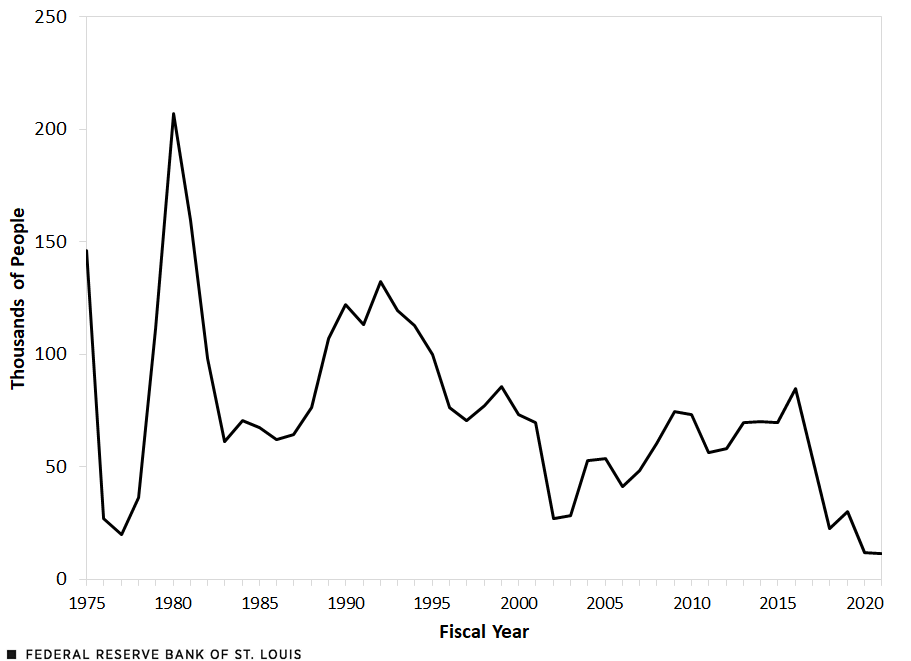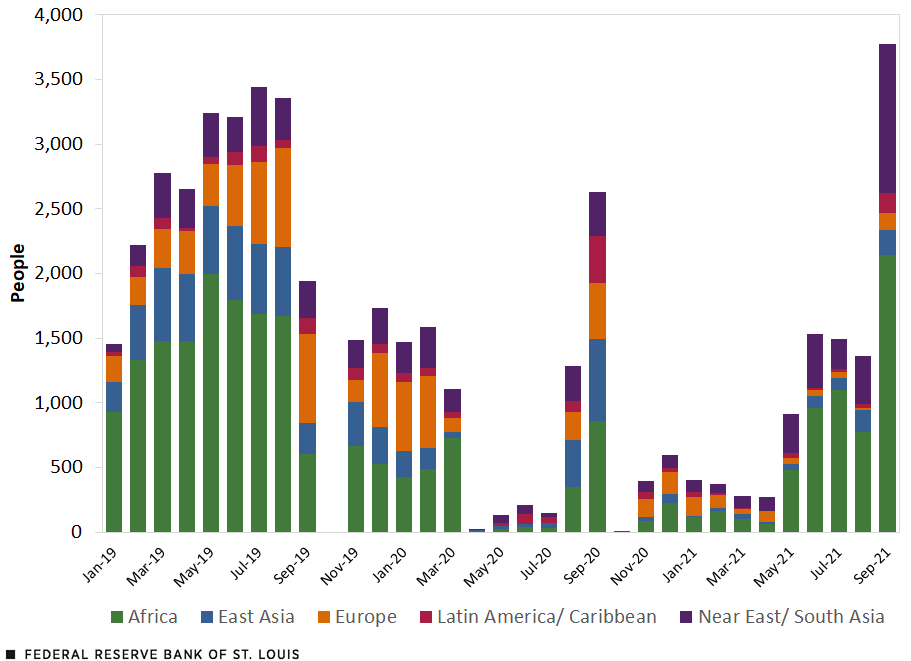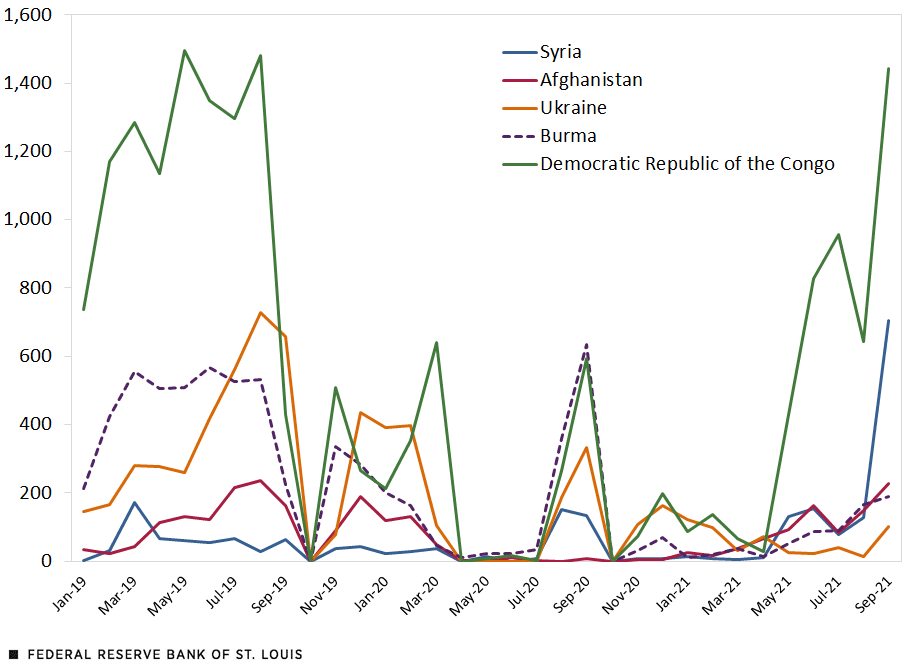A Look at Recent Refugee Admissions into the U.S. amid COVID-19 Disruptions
The recent exit of the U.S. military from Afghanistan and the associated plight of many Afghans who wanted to flee are a painful reminder of the importance of U.S. refugee policies. Similarly, Haiti has been in turmoil in recent months, especially after the assassination of President Jovenel Moïse in July. At the same time, COVID-19 pandemic-related disruptions have posed challenges to the United States Refugee Admissions Program.
In this blog post, we first present a longer-run picture of refugee admissions to the U.S. It is important to note that refugee admissions to the U.S. are limited by ceilings based on a fiscal year (Oct. 1 of preceding calendar year to Sept. 30 of the current calendar year) established by the president in consultation with Congress. While the ceiling has been reached in some years, in others various factors contribute to a shortfall. Then we take a closer look at the recent monthly data to see how refugee admissions have evolved in the face of the pandemic, among other factors. We also identify the nations that have contributed to recent refugee admissions.
Refugees Admitted to the U.S.

SOURCES: The U.S. Department of State’s Refugee Processing Center and authors’ calculations.
Annual Refugee Admissions since the Mid-1970s
The first figure does not identify refugees by source nations because of data limitations, but the policy response to the Vietnam War and the Iranian revolution, among other factors, contributed to a large refugee influx in the early 1980s. According to the Migration Policy Institute, “Immigration from Iran increased dramatically following the Islamic Revolution and the 1980-88 Iran-Iraq war.” In comparison, refugee admissions have dropped sharply in recent years, driven by stricter refugee admission ceilings and by the impact of ongoing COVID-19 disruptions. Indeed, the pandemic has had a major effect in slowing down admissions—the ceiling in fiscal year 2020 was a modest 18,000, but only 11,814 were actually admitted.
Contributing factors to this slowdown were myriad disruptions, exemplified by the suspension of refugee admissions program travel between March and July 2020. Most recently, the Biden administration raised the refugee admissions ceiling to 62,500 for fiscal year 2021 and proposed the ceiling to be raised further to 125,000 for fiscal year 2022. However, actual admissions for fiscal year 2021 were only at 11,411 people, far below the revised 2021 limit. Barring further unforeseen disruptions, refugee admissions can be expected to rise in the near future.
Where Do the Recent Refugees Come From?
Using monthly data, we constructed the next two figures. The figure below shows that in recent months the vast majority of refugees have come from Africa, followed by the Near East/South Asia. In spite of the very modest numbers for fiscal year 2021, recent data shows an uptick of refugee admissions, reflecting perhaps both the more accommodative ceilings and also a reduction in COVID-related disruptions.
Monthly Refugee Admissions to the U.S.

SOURCES: The U.S. Department of State’s Refugee Processing Center and authors’ calculations.
Drilling deeper, the next figure highlights refugee admissions by the top five source nations. All these nations have seen major political upheavals. Syria has seen a horrific civil war, and the Democratic Republic of the Congo has faced violence in different regions of the nation and general political instability. Afghanistan witnessed the gradual increase in Taliban control of different regions of the nation, culminating in the group’s recent takeover of the country. Burma has witnessed the Rohingya conflict among other ethnic disturbances and also a military coup in February of 2021. Meanwhile, Ukraine has seen ongoing and intermittent conflict on its eastern border with Russia.
Top 5 Countries of Chargeability for Refugees Admitted to the U.S.

SOURCES: The U.S. Department of State’s Refugee Processing Center and authors’ calculations.
Conclusion
U.S. policy regarding refugee admissions had become more restrictive in recent years, but admission ceilings were sharply raised for fiscal years 2021 and 2022. However, COVID-19 and associated disruptions have led to much smaller numbers of admissions in 2020 and 2021 than the policy-imposed ceilings. Recent source nations have experienced civil wars, military coups and regime changes, which spur the decision by people to flee their homelands. Although the current policies have turned less restrictive, the evolution of future policy is hard to predict because it has to adapt to changing geopolitical events as well as to evolving domestic conditions in the U.S.
Notes and References
- It is important to note that refugee admissions to the U.S. are limited by ceilings based on a fiscal year (Oct. 1 of preceding calendar year to Sept. 30 of the current calendar year) established by the president in consultation with Congress. While the ceiling has been reached in some years, in others various factors contribute to a shortfall.
Citation
Subhayu Bandyopadhyay and Praew Grittayaphong, ldquoA Look at Recent Refugee Admissions into the U.S. amid COVID-19 Disruptions,rdquo St. Louis Fed On the Economy, Dec. 16, 2021.
This blog offers commentary, analysis and data from our economists and experts. Views expressed are not necessarily those of the St. Louis Fed or Federal Reserve System.
Email Us
All other blog-related questions



